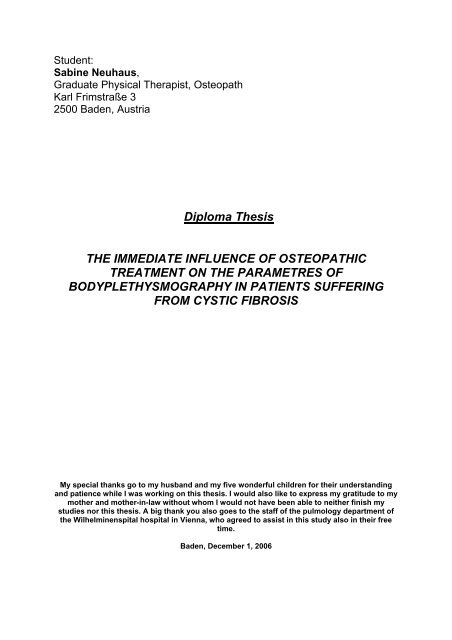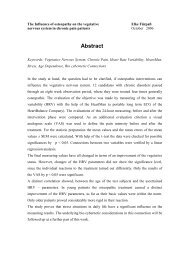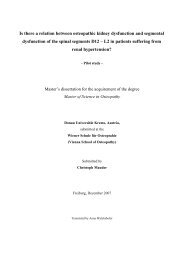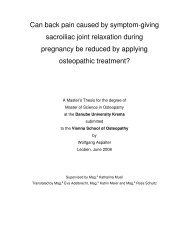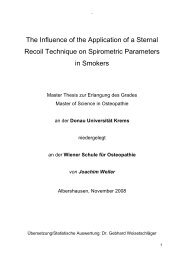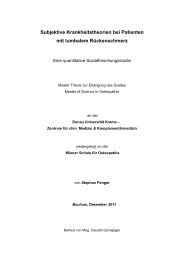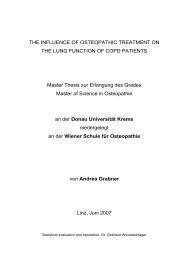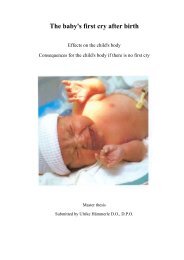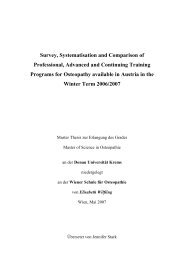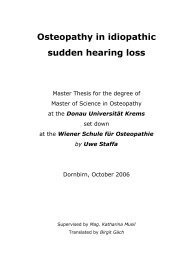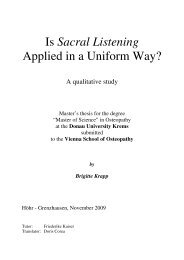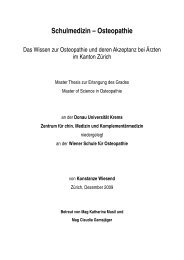Diploma Thesis THE IMMEDIATE INFLUENCE OF OSTEOPATHIC ...
Diploma Thesis THE IMMEDIATE INFLUENCE OF OSTEOPATHIC ...
Diploma Thesis THE IMMEDIATE INFLUENCE OF OSTEOPATHIC ...
You also want an ePaper? Increase the reach of your titles
YUMPU automatically turns print PDFs into web optimized ePapers that Google loves.
Student:<br />
Sabine Neuhaus,<br />
Graduate Physical Therapist, Osteopath<br />
Karl Frimstraße 3<br />
2500 Baden, Austria<br />
<strong>Diploma</strong> <strong>Thesis</strong><br />
<strong>THE</strong> <strong>IMMEDIATE</strong> <strong>INFLUENCE</strong> <strong>OF</strong> <strong>OSTEOPATHIC</strong><br />
TREATMENT ON <strong>THE</strong> PARAMETRES <strong>OF</strong><br />
BODYPLETHYSMOGRAPHY IN PATIENTS SUFFERING<br />
FROM CYSTIC FIBROSIS<br />
My special thanks go to my husband and my five wonderful children for their understanding<br />
and patience while I was working on this thesis. I would also like to express my gratitude to my<br />
mother and mother-in-law without whom I would not have been able to neither finish my<br />
studies nor this thesis. A big thank you also goes to the staff of the pulmology department of<br />
the Wilhelminenspital hospital in Vienna, who agreed to assist in this study also in their free<br />
time.<br />
Baden, December 1, 2006
TABLE <strong>OF</strong> CONTENTS<br />
1 INTRODUCTION.............................................................................................................. 3<br />
2 MEDICAL FACTS ............................................................................................................ 5<br />
2.1 PATHOPHYSIOLOGY <strong>OF</strong> CF ................................................................................. 5<br />
2.1.1 HEREDITARY TRANSMISSION <strong>OF</strong> CF........................................................ 5<br />
2.1.2 INCIDENCE <strong>OF</strong> CF .......................................................................................... 7<br />
2.1.3 CHARACTERISTICS <strong>OF</strong> CF ........................................................................... 8<br />
2.1.3.1 <strong>THE</strong> CF LUNG ....................................................................................... 10<br />
2.1.3.2 <strong>THE</strong> CF PANCREAS ............................................................................ 12<br />
2.1.3.3 <strong>THE</strong> CF INTESTINES........................................................................... 13<br />
2.1.3.4 CF – LIVER AND GALLBLADDER.................................................... 15<br />
2.1.3.5 <strong>THE</strong> ENT - REGION ............................................................................. 16<br />
2.1.3.4. ELECTROLYTE BALANCE....................................................................... 17<br />
2.1.3.5. <strong>THE</strong> HEART IN CF PATIENTS........................................................... 18<br />
2.1.3.6 .FERTILITY IN CF ................................................................................. 19<br />
2.1.3.7 LOCOMOTOR SYSTEM IN CF........................................................... 20<br />
2.1.3.8 PSYCHOSOCIAL ASPECTS IN CF................................................... 22<br />
2.2 DIAGNOSIS <strong>OF</strong> CF ................................................................................................ 24<br />
2.3 <strong>THE</strong>RAPY <strong>OF</strong> CF ................................................................................................... 25<br />
2.4 LUNG FUNCTION MEASUREMENT AND ITS PARAMETERS...................... 27<br />
3 RESEARCH QUESTION ................................................................................................ 29<br />
4 RELEVANCE FOR OSTEOPATHY .............................................................................. 29<br />
5 HYPO<strong>THE</strong>SIS ................................................................................................................. 29<br />
6 STUDY DESIGN............................................................................................................. 30<br />
METHODOLOGY................................................................................................................... 31<br />
6.1 SAMPLING ............................................................................................................. 31<br />
6.2 INCLUSION CRITERIA......................................................................................... 31<br />
6.3 EXCLUSION CRITERIA........................................................................................ 31<br />
6.4 RANDOMIZATION................................................................................................ 32<br />
6.5 PLANNED PROCEDURE ...................................................................................... 32<br />
6.6 VARIABLES ........................................................................................................... 34<br />
6.7 VALIDITY, RELIABILITY.................................................................................... 34<br />
7 RESULTS......................................................................................................................... 35<br />
8 DISCUSSION .................................................................................................................. 38<br />
9 SUMMARY ..................................................................................................................... 39<br />
10 BIBLIOGRAPHY ........................................................................................................ 41<br />
10.1 FUR<strong>THE</strong>R READING............................................................................................. 44<br />
11 ANNEX........................................................................................................................ 47<br />
11.1 CONTACT INFORMATION .................................................................................. 47<br />
11.2 ENGLISH TRANSLATION <strong>OF</strong> FIGURES ............................................................ 49<br />
11.3 PATIENT DATA SHEETS ..................................................................................... 50<br />
12 ABSTRACT................................................................................................................. 51
1 INTRODUCTION<br />
Why I think this study is important.<br />
Since I am personally concerned with cystic fibrosis in my family (sadly two of my<br />
sister’s children suffer from it), I got to know and treat many CF patients throughout<br />
the years.<br />
Cystic fibrosis (CF), which used to be called mucoviscidosis, is the most common<br />
severe congenital metabolic disorder in Europe and among the Caucasian<br />
population 1 .<br />
The average life expectancy currently ranges between 40 and 45 years 2 , and has<br />
increased considerably over the past few years due to improved medical treatment<br />
methods and early diagnosis.<br />
When shortly after the birth of my nephew 20 years ago he was diagnosed with this<br />
disease through a test which then was fortunately carried out on a routine basis at<br />
the hospital in Baden, it was said that he would only live a few years. Thank God he<br />
now is a handsome young man who copes fairly well with the CF.<br />
Since November 1998 an early detection test for CF 3 is applied all over Austria within<br />
the framework of the “newborn screening”. In many countries, though, this is not the<br />
case. 4 .<br />
But the age when CF is diagnosed is very decisive for the life expectancy of the<br />
patient, because without treatment the lethality of this disease during the first years of<br />
life ranges around 90% 5 )<br />
I have already treated a number of patients with CF and was able to observe<br />
considerable subjective improvements after the osteopathic treatment. Some of my<br />
osteopathic colleagues also told me about similarly successful treatments. Thus I<br />
started to look in books and online for papers or experience reports of other<br />
osteopaths who worked successfully with this kind of patients and was surprised to<br />
practically find myself on medical “terra incognita”.<br />
1 Reinhardt et al., 2001, p. 255<br />
2 Eichler et al., 2004, p. 4<br />
3 www.docs4you.at, 21.9.06<br />
4 Bauer AW., 2006, p.1-13, www.aerztezeitung.de 22.9.06<br />
5 www.akh-consilium.at,28.12.05<br />
<strong>Diploma</strong> <strong>Thesis</strong> Sabine Neuhaus page 3 of 52
Since my interest was already raised and since also a number of my patients and<br />
relatives urged me to write this paper I decided to choose this topic for my diploma<br />
thesis. Another reason for doing so was that I had received a lot of positive feedback<br />
for my article in the CF magazine “Leben” 6 and a presentation on “CF and<br />
osteopathy”, which I held at a CF congress in Salzburg in 2004.<br />
Figure 1 www.breathlife.ca<br />
This picture, which has touched me very much, shows a typical young probably lungtransplanted<br />
CF patient.<br />
6 Journal. CF - Zeitschrift “Leben”, 2005, Ausgabe 1:4-5<br />
<strong>Diploma</strong> <strong>Thesis</strong> Sabine Neuhaus page 4 of 52
2 MEDICAL FACTS<br />
2.1 PATHOPHYSIOLOGY <strong>OF</strong> CF<br />
2.1.1 HEREDITARY TRANSMISSION <strong>OF</strong> CF<br />
CF is a congenital disease passed on by both parents.<br />
Cystic fibrosis is an autosomal recessive (affecting chromosome 7) metabolic<br />
disease 7 .<br />
This means that the carriers of the concerned chromosome are not affected by the<br />
disease. But if two CF-chromosomes meet, i.e. if both parents pass on the CFchromosome<br />
to their child, the disease manifests. With two CF carriers as parents<br />
the probability to be affected by CF is thus 25%, to become a carrier of the defective<br />
gene oneself is 50% and not to carry the CF gene and therefore not to carry the risk<br />
to pass it on 25%.<br />
7 Reinhardt et al., 2001, p.3-5<br />
<strong>Diploma</strong> <strong>Thesis</strong> Sabine Neuhaus page 5 of 52
Figure 2 - Scriptum, Med. Univ. Wien, “Expression von Allelen”, Prof. Fonatsch, 2005<br />
AUTOSOMAL RECESSIVE TRANSMISSION<br />
The probability of hereditary transmission can be illustrated as shown in figure 2.<br />
“N” stands for “normal”, i.e. healthy chromosome, “r” means “recessive”, i.e. in the<br />
case of CF, an affected chromosome.<br />
Human DNA has the form of a double helix and is made up of 23 pairs of<br />
chromosomes. The genes which carry the information for a particular trait occupy<br />
specific positions on specific chromosomes. Alleles are alternative forms (mutations)<br />
of a gene; they are thus responsible for abnormal changes in the genetic material 8 .<br />
CF can only be transmitted if both parents carry the CF gene and pass it on to<br />
their child. If the child receives only one defective gene, he/she is healthy but<br />
can pass CF on to his/her future children.<br />
8 Knippers R., 2001, p.212-213<br />
<strong>Diploma</strong> <strong>Thesis</strong> Sabine Neuhaus page 6 of 52
2.1.2 INCIDENCE <strong>OF</strong> CF<br />
About the incidence of cystic fibrosis<br />
Figure 3 - Scriptum, Med. Univ. Wien, „Expression von Allelen“, Prof. Fonatsch, 2005<br />
(cf. Annex for the English translation of Figure 3)<br />
As already mentioned in the introduction and as illustrated in figure 3 the incidence<br />
(statistical number of new cases of the disease) of CF is very high in our latitudes.<br />
The overall incidence among the Caucasian population ranges around 1:2500, while<br />
it is clearly below in other ethnic groups.<br />
Thus CF is the most frequent severe hereditary disease among the Caucasian<br />
population 9 .<br />
9 Reinhardt et al., 2001, p.255<br />
<strong>Diploma</strong> <strong>Thesis</strong> Sabine Neuhaus page 7 of 52
2.1.3 CHARACTERISTICS <strong>OF</strong> CF<br />
Organ manifestations in cystic fibrosis<br />
Figure 4 clearly illustrates how frequent and in which form the individual organs are<br />
affected.<br />
Organ<br />
Pathologische<br />
Anatomie<br />
Symptomatik Ursache Häufigkeit Manifestationsalter<br />
Lunge<br />
Atelektasen,<br />
Emphysem,<br />
Mikroabszesse,<br />
Bronchiektasen,<br />
Fibrosierung<br />
Bronchitiden und<br />
Pneumonien *), chronischer<br />
Husten, Auswurf, Dyspnoe,<br />
Zyanose<br />
Sekretbeschaffenheit,<br />
Superinfektionen<br />
fast obligat<br />
variabel, oft<br />
Säuglingsalter<br />
Herz Cor pulmonale<br />
Symptome der<br />
Rechtsherzinsuffizienz<br />
Lungenveränderungen häufig meist präfinal<br />
Pankreas<br />
Pankreas<br />
zystische<br />
Degeneration und<br />
Fibrose oder<br />
Lipomatose<br />
Schädigung der<br />
Inselzellen<br />
Maldigestion, Dystrophie,<br />
Rektumprolaps<br />
Sekretbeschaffenheit ± 90 % meist Säuglingsalter<br />
Diabetes Mellitus ohne<br />
Ketoazidose<br />
Insulinmangel ± 10 % > 10 Jahre<br />
Darm<br />
Ileus durch:<br />
Mekonium,<br />
eingedickten Kot<br />
Mekoniumileus,<br />
10-15 %<br />
Stuhlbeschaffenheit<br />
Mekoniumileus-Äquivalent selten<br />
Säuglinge meist > 10<br />
Jahre<br />
Leber<br />
grobknotige<br />
Leberzirrhose<br />
portale Hypertension,<br />
Hypersplenismus<br />
Ösophagusvarizen<br />
Störung der<br />
Gallesekretion<br />
5-10 % meist > 10 Jahre<br />
Leber<br />
Cholelithiasis,<br />
Störung der<br />
Gallenkoliken etc. bis 30 % meist > 10 Jahre<br />
Cholezystitis Gallesekretion<br />
Schweißdrüsen –<br />
salziger Körpergeschmack,<br />
Neigung zu<br />
hypernatriämischer<br />
Dehydratation<br />
Elektrolyttransportstörung obligat Säuglingsalter<br />
Vas deferens<br />
Atrophie (intrauterin<br />
entstehend)<br />
Sterilität durch Azoospermie Unbekannt > 95 % postpubertär<br />
HNO-Bereich<br />
Hyperplasie<br />
d.Schleimdrüsen,<br />
Polyposis nasi<br />
behinderte Nasenatmung<br />
25 %<br />
Sekretbeschaffenheit<br />
chronische Sinusitis selten<br />
variabel<br />
Figure 4 - www.akh.consilium.at, Medizinische Universität Wien, 28.12.05<br />
(cf. Annex for the English translation of figure 4)<br />
<strong>Diploma</strong> <strong>Thesis</strong> Sabine Neuhaus page 8 of 52
The disease goes hand in hand with a disturbed water-salt balance in all exocrine<br />
glands (glands of external secretion) of the body. Viscous and thick secrete clog the<br />
openings of the glands, which gradually are replaced by cysts and connective tissue<br />
and die off 10 .<br />
In the following section I would like to focus on the organs which are most commonly<br />
affected, and their symptoms. These are also the organs which are most important in<br />
the osteopathic treatment of the disease.<br />
CF is a disease which affects many systems, above all the exocrine glands of<br />
the body.<br />
10 Knippers R., 2001, p.483<br />
<strong>Diploma</strong> <strong>Thesis</strong> Sabine Neuhaus page 9 of 52
2.1.3.1 <strong>THE</strong> CF LUNG<br />
The lung – the organ which is most commonly affected in cystic fibrosis.<br />
From a histoanatomic point of view it is thought that children with CF are born with a<br />
normal lung. But from the moment when the child starts breathing his/herself the<br />
metabolic defect, whose function is not well understood so far, causes an abnormal<br />
production of a highly viscous secrete rich in protein and electrolytes in the lung. The<br />
bronchi and bronchioli become blocked, which causes an impaired respiratory<br />
function and lack of oxygen (due to this lack of oxygen the so-called clubbed fingers<br />
can be frequently observed in CF patients). An accumulation of the viscous mucus<br />
favours infections, which last very long and are difficult to treat. The frequent<br />
coughing produces pathologic changes in the upper respiratory tract (instability of the<br />
bronchial walls, hyperreactivity of the bronchial system) and the lung tissue itself 11 .<br />
Due to an obstruction (narrowing) of the air passages (because of mucus<br />
accumulation but also because of spasticity) the resistance in the respiratory tract is<br />
increased. This leads to an increasing hyperinflation of the lungs. Due to the<br />
formation of atelectasis (collapsed, not ventilated alveloi), emphysematic lung areas<br />
and the formation of fibrosis in the lung parenchyma the alveolar region becomes<br />
limited in its function and size. The obstruction and restriction (reduction of the<br />
inflatable lung tissue) leads to a disturbed pulmonary gas exchange. This entails a<br />
compensatory increased respiratory work and thus an overstraining of the respiratory<br />
muscles 12 . I have made the experience that not only the respiration rate but also the<br />
respiration pattern changes in a way that the secondary (accessory) muscles of<br />
respiration are used more and more and the important diaphragmatic respiration is<br />
increasingly abandoned or even unlearned.<br />
11 Reinhardt et al., 2001, p.266-344<br />
12 Kieselmann R., www.muko.net 9.7.2001<br />
<strong>Diploma</strong> <strong>Thesis</strong> Sabine Neuhaus page 10 of 52
This means that the above mentioned pathological changes of the thorax and lungs<br />
become more pronounced. The form and function of the whole thorax and spine are<br />
altered considerably due to the changes in the lung tissue and in the balance of the<br />
muscles and fascia: the kyphosis of the thoracic spine increases and the thorax is<br />
fixed in an inspiration position. The deformation of the thoracic cage is also favoured<br />
by the fact that the straight abdominal muscles are too strong in relation to the<br />
oblique abdominal muscles due to the frequent coughing.<br />
Lung damage is the leading cause of death among CF patients 13 .<br />
Figure 5 - CF lung at www.meddean.luc.edu, Dec. 28, 2005<br />
Figure 5 clearly illustrates the obstruction of the lung tissue.<br />
The CF lungs and the whole thorax are affected by a number of pathologic<br />
changes, which are considered as the most frequent causes of death in CF<br />
patients.<br />
13 Eichler et al., 2004, p.2<br />
<strong>Diploma</strong> <strong>Thesis</strong> Sabine Neuhaus page 11 of 52
2.1.3.2 <strong>THE</strong> CF PANCREAS<br />
Also the pancreas becomes progressively obstructed and fibrotic.<br />
Like all exocrine glands in the body also the pancreas produces an abnormal<br />
secretion which causes pancreatic insufficiency relatively early. This means that<br />
above all the digestion of fat is disturbed and the lacking digestive enzymes have to<br />
be supplemented through medication. If the pancreatic enzymes are not<br />
supplemented the CF patients will suffer from abdominal pain and foul smelling fatty<br />
diarrhoea. This entails a malabsorption of nutrients which causes symptoms of<br />
vitamin and protein deficiencies, bloating of the abdomen, anaemia, poor growth, as<br />
well as ravenous appetite alternating with loss of appetite 14 .<br />
The progressive formation of fibrotic tissue of the pancreas very often leads to<br />
secondary diabetes 15 .<br />
Due to an insufficient function of the pancreas digestive enzymes have to be<br />
supplemented in general and if necessary insulin has to be administered.<br />
14 Reinhardt et al., 2001, p.368-377<br />
15 Mackie et al., 2003, p.425-436<br />
<strong>Diploma</strong> <strong>Thesis</strong> Sabine Neuhaus page 12 of 52
2.1.3.3 <strong>THE</strong> CF INTESTINES 16<br />
The intestine – usually a problem in infants, more rarely in adults.<br />
The biggest problems concerning the intestines usually are a meconium ileus (failure<br />
to pass the first stools (meconium) due to an obstruction of the terminal ileum) in<br />
newborns, and a meconium ileus equivalent syndrome (distal intestinal obstruction<br />
syndrome or DIOS) or a rectum prolapse (the lining of the rectum pushes out through<br />
the anus), which are common in infants and small children. These symptoms often<br />
are the first indicators for CF.<br />
The most important clinical findings and hints from the case history pointing towards<br />
DIOS are: alternating stool consistency, a bloated abdomen which is sensitive to<br />
touch, abdominal pain and vomiting.<br />
In childhood and as adults CF patients often suffer from chronic constipation. In CF<br />
patients who have a persistent anaemia, failure to thrive (FTT) and frequent<br />
diarrhoea despite an adequate enzyme supplementation and nutrient supply the<br />
additional diagnosis of coeliac disease should be considered. Coeliac disease can<br />
also be a first hint pointing towards CF.<br />
Chronic inflammatory diseases of the intestines like ulcerative colitis and Crohn’s<br />
disease occur frequently in CF patients.<br />
The risk for a CF patient to develop a malign carcinoma in the gastrointestinal tract is<br />
about 6.5 times higher than in the comparable healthy population group.<br />
16 Reinhardt et al., 2001, p.382-396<br />
<strong>Diploma</strong> <strong>Thesis</strong> Sabine Neuhaus page 13 of 52
Figure 6 Rectum prolapse at www.klinikumkonstanz.de<br />
Sept. 5, 2006<br />
Figure 6 shows an extreme case of a rectum prolapse, where the lining of the rectum<br />
pushes out of the anus.<br />
If newborns and infants suffer from meconium ileus, a rectum prolapse and<br />
fatty, foul smelling stools they should be examined and tested for CF.<br />
<strong>Diploma</strong> <strong>Thesis</strong> Sabine Neuhaus page 14 of 52
2.1.3.4 CF – LIVER AND GALLBLADDER<br />
Changes in the liver and bile duct – additional organs that can be affected in<br />
many CF patients.<br />
In quite a large number of CF patients the clinical course of the disease is<br />
complicated by the fact that also the liver and the extrahepatic bile duct system are<br />
affected. A fatty degeneration of the liver represents the most common pathological<br />
change in this area. Such a change can be observed in 60 – 80% of the CF patients.<br />
From a clinical point of view the change in the liver is usually inconspicuous thus no<br />
therapeutic measures are necessary. 20 – 70% of all CF patients also suffer from<br />
cirrhosis of the liver which originates at the bile ducts and is limited to a local area<br />
(focal biliary cirrhosis). Often a chronic obstruction of the efferent bile ducts is<br />
suspected to be the cause. In many cases a sort of dull, crushing pain occurs in the<br />
right upper abdominal region. The most severe involvement of the liver in CF is<br />
multilobular cirrhosis, where only individual liver lobules are spared from the<br />
formation of fibrotic tissue. 5% of all children older than 5 years and 25% of all adults<br />
older than 25 years are affected. These problems affect above all patients whose<br />
pulmonary function is not or only minimally limited. The prognosis for this form of liver<br />
cirrhosis is very unfavourable and usually ends lethally 17 .<br />
CF-associated liver diseases are the second most frequent causes of death (1-2%) in<br />
patients suffering from cystic fibrosis 18 .<br />
Changes in the liver occur frequently but are not so significant from a clinical<br />
point of view. Multilobular cirrhosis is not very common in CF patients, but if it<br />
occurs it usually ends lethally.<br />
17 Reinhardt et al., 2001, p.404-406<br />
18 Eichler et al., 2004, p.2<br />
<strong>Diploma</strong> <strong>Thesis</strong> Sabine Neuhaus page 15 of 52
2.1.3.5 <strong>THE</strong> ENT - REGION<br />
The air sinuses – like the lung almost always affected in CF.<br />
In almost 100% of all CF patients of all age groups radiographic examinations of the<br />
sinuses show a pansinusitis. Since usually a pansinusitis occurs rarely in children, all<br />
children and adolescents who suffer from it should be examined and tested for CF. In<br />
36% of all CF patients the frontal sinuses are not developed 19 .<br />
If the frontal sinuses are developed, their size is often reduced in comparison with<br />
healthy persons 20 .<br />
Really pronounced affections of the sinuses can be observed in less than 10% of the<br />
children and in about 25% of the adults suffering from CF. Like the bronchial<br />
secretion the mucus secreted in sinusitis is often contaminated by various pathogens.<br />
The patients frequently suffer from headaches, impaired nasal breathing, swelling in<br />
the face, halitosis and fever 21 .<br />
A quarter of all patients also suffer from nasal polyps 22 .<br />
About 3% of all newly diagnosed CF patients are diagnosed because of nasal polyps<br />
or sinusitis. 23<br />
In general all children with nasal polyps should be examined and tested for CF 24 .<br />
Like the lungs, in most cases also the air sinuses are clogged with mucus and<br />
infested with pathogens.<br />
19 Reinhardt et al., 2001, p.446<br />
20 Mackay IS et al., 1994, p.17<br />
21 Reinhardt et al., 2001, p.446<br />
22 Eichler et al., 2004, p.2<br />
23 Reinhardt et al., 2001, p.445<br />
24 Mackay IS et al., 1994, p.17<br />
<strong>Diploma</strong> <strong>Thesis</strong> Sabine Neuhaus page 16 of 52
2.1.3.4. ELECTROLYTE BALANCE<br />
Generally the cause of the disease patterns linked with CF can be found in a<br />
disturbed salt balance on a cellular level.<br />
At the bottom of the clinical picture of cystic fibrosis a severe dysfunction of the<br />
electrolyte transport of the epithelial tissue can be observed. As already mentioned<br />
all organs with exocrine glands are affected. This also includes the salivary and<br />
sudoriferous glands. Due to the defect the salt concentration of the sudor is 2 – 5<br />
times higher than in a healthy person. This fact can be used to diagnose CF by<br />
means of a sweat test. In hot weather, when practicing sports or suffering from a<br />
fever the electrolyte balance can become disturbed quite easily if the patient does not<br />
make sure to supply enough salt and water. This imbalance can be additionally<br />
aggravated by the above mentioned diarrhoea and the loss of salt in the sputum. If<br />
such an imbalance persists for a longer period of time, this can lead to dehydration,<br />
subfebrile temperatures and failure to thrive especially in small children. 25 .<br />
I have observed that in general the administration of isotonic drinks has proven to be<br />
of value not only in cases of increased activity or other sorts of prolonged strain. In<br />
addition, the coughing up of phlegm from the lungs seems to be supported as well.<br />
In CF the patients loose more salt which has to be balanced especially under<br />
circumstances of increased activity or stress.<br />
25 Reinhardt et al., 2001, p.189<br />
<strong>Diploma</strong> <strong>Thesis</strong> Sabine Neuhaus page 17 of 52
2.1.3.5. <strong>THE</strong> HEART IN CF PATIENTS 26<br />
The heart also suffers from pathologic changes when the pulmonary function<br />
deteriorates.<br />
With the growing life expectancy the involvement of the heart as a consequence of<br />
the obstructive pulmonary disease has become more important especially for adult<br />
CF patients. About a quarter of the adult CF patients are concerned by heart<br />
problems. The clearly reduced oxygen supply in CF usually leads to a hypoxiainduced<br />
vasoconstriction of the pulmonary artery and as a consequence results in a<br />
pulmonary hypertension. This again leads to a thickening of the muscle layer of the<br />
pulmonary blood vessels entailing a right ventricular hypertrophy. Clinical indicators<br />
for that are: cyanosis, accelerated respiration rate, congestion of the neck veins,<br />
hepatomegaly and oedema. In addition to the administration of certain medications,<br />
the therapy in this case consists in a long-term oxygen supply because it counteracts<br />
the progression of the disease pattern.<br />
26 Reinhardt et al., 2001, p.347-353<br />
<strong>Diploma</strong> <strong>Thesis</strong> Sabine Neuhaus page 18 of 52
2.1.3.6 .FERTILITY IN CF<br />
Most female CF patients have no difficulties to become pregnant. Parenthood<br />
with CF, however, implicates other serious problems.<br />
Due to the growing life expectancy “parenthood” has become an issue for many CF<br />
patients, even though “having a child” involves a number of problems not only for the<br />
mother during pregnancy and birth, but also for both parents afterwards because of<br />
the possibly short life span. 95% of all male CF patients are infertile due to a<br />
verifiable obstructive azoospermia or bilaterally lacking vas deferens. 27 .<br />
Nevertheless it is possible to re-establish fertility by means of surgical intervention. 28 .<br />
Female CF patients usually do not have any problems to become pregnant.<br />
Dependent on the health status of the mother the perinatal mortality ranges around<br />
35%. 29 .<br />
“Many pregnancies are completed surprisingly well and without major consequences<br />
despite a reduced pulmonary function.” 30<br />
27 Reinhardt et al., 2001, p.459-462<br />
28 Journal für Urologie und Gynäkologie, p.20-23<br />
29 Hubert et al., 1994, 50(6): p.299-306<br />
30 Reinhardt et al., 2001, p. 456-459<br />
<strong>Diploma</strong> <strong>Thesis</strong> Sabine Neuhaus page 19 of 52
2.1.3.7 LOCOMOTOR SYSTEM IN CF<br />
Due to the number of affected organs and the resulting functional changes the<br />
whole locomotor system of the patient is subject to pathologic changes.<br />
It is not clear why, but osteoporosis is very common among adult CF patients 31 .<br />
Nevertheless adolescents can be affected as well 32 . Therefore compression fractures<br />
of vertebral bodies, fractures and true kyphoses occur relatively frequently. It is<br />
supposed that due to pancreatic insufficiency and fatty stools up to 80% of the<br />
normally ingested calcium is lost by defecation. Reduced physical activity, poor<br />
nutrition and therapeutic administration of glucocorticosteroids aggravate the loss of<br />
calcium and demineralization even more. For 15% of the CF patients hypertrophic<br />
pulmonary osteoarthropathy poses an additional problem. This condition is a<br />
combination of clubbed fingers (not always), chronic periostitis of the long bones and<br />
a symmetric synovitis of the large articulations (knees, ankles, wrists) with a possible<br />
reduced function. Swellings, raised temperatures and joint effusions can produce<br />
similar pictures to those of arthritides. Transitions with other arthritic disease patterns<br />
are possible and difficult to differentiate. Patients with periostitis generally show<br />
significantly worse pulmonary functions and a higher mortality rate. Antibiotics can<br />
also cause arthritis in CF patients, especially in the knee and wrist joints. Once the<br />
medication is discontinued the complaints disappear although sometimes slightly<br />
delayed 33 .<br />
31 Aris et al., 1998, p.186-193<br />
32 Latzin et al., 2005, p.616-618<br />
33 Reinhardt et al 2001, p.447-454<br />
<strong>Diploma</strong> <strong>Thesis</strong> Sabine Neuhaus page 20 of 52
I have observed that the continuous coughing provokes a shortening of the straight<br />
abdominal muscles and the entire anterior muscle and fascia chain. By-and-by this<br />
produces a very kyphotic posture and results in problems like pain in the regions of<br />
the cervical spine and thoracic cage. Due to the imbalance in the muscle power<br />
between the straight and the oblique abdominal muscles and due to the increased<br />
involvement of the accessory muscles of breathing the thoracic cage becomes<br />
deformed in a typical way (a cranially and ventrally protruding sternum; a small<br />
epigastric angle and retracted 7 th /8 th ribs 34 ).<br />
Figure 7 Clubbed fingers<br />
Figure 7 shows the typical clubbed finger tips which I have already described.<br />
34 Reinhardt et al 2001, p.311<br />
<strong>Diploma</strong> <strong>Thesis</strong> Sabine Neuhaus page 21 of 52
2.1.3.8 PSYCHOSOCIAL ASPECTS IN CF<br />
CF involves many multifaceted problems and represents a great challenge for<br />
all people concerned.<br />
Many times I have experienced that the diagnosis of their child with CF is a<br />
completely unexpected blow to the parents. Suddenly they have to deal with an<br />
“incurable disease”. Like many of my colleagues, who work with CF patients, I could<br />
also witness that this shock affects the whole family 35 . In addition CF requires a very<br />
intensive therapy and control, which implies numerous visits to the hospital with<br />
numerous examinations which mean a lot of stress and fear for both the child and the<br />
parents. I could observe myself how often the parents are required to cede the<br />
responsibility for their child to the attending doctors, which leads to a lot of conflicts<br />
until a “joint way” can be found. In adolescent CF patients the denial of the disease is<br />
an important factor. The young patients often refuse the necessary therapies at first,<br />
thus later on extremely elaborate treatments have to be undertaken.<br />
Moreover, adolescence is the time when the first sexual encounters take place, which<br />
again confronts the young patients with many new questions and problems and<br />
requires special medical attendance 36 .<br />
According to my observations the disease also causes stress and problems in school<br />
because the therapies are very time-consuming and the patients are often ill so they<br />
cannot cope with the amount of subject matters they are supposed to learn.<br />
Adolescence is also the time when the young CF patients detach themselves from<br />
their parents and attending doctors and take on responsibility for themselves.<br />
35 Roth EM., 2005, p.4-6, Reinhardt et al., 2001, p.551-557, Wilkinson J., 1987, P.7-8<br />
36 Roberts S. et al., 2005, p.7-16<br />
<strong>Diploma</strong> <strong>Thesis</strong> Sabine Neuhaus page 22 of 52
From experience and also from patients’ reports 37 we know that also in adulthood CF<br />
patients are confronted with difficult decisions (family planning, job planning, financial<br />
situation….).<br />
In addition, the grown-up patients have to change the hospital or hospital ward<br />
because they no longer can be treated at the children’s ward. This again presents the<br />
patients but also the hospital staff with additional problems 38 .<br />
A permanent companion for CF patients is the fear to suddenly find themselves in a<br />
life-threatening state. Often this really happens, and sometimes a lung<br />
transplantation which involves a long time in hospital, long rehabilitation and a<br />
change of lifestyle becomes necessary. Naturally, all theses things involve big<br />
conflicts and problems for the whole family. Thus all attending practitioners are<br />
required to act with a lot of empathy and psychological competence.<br />
In working with CF patients and their families a lot of empathy as well as<br />
professional expertise and psychological competence are necessary.<br />
37 Journal Leben mit Cystischer Fibrose, Ausg 1, 2006, p.7,8<br />
38 Webb AK. Et al., 2001, p.8-11, Bryon M. et al., 2001, p.5-7<br />
<strong>Diploma</strong> <strong>Thesis</strong> Sabine Neuhaus page 23 of 52
2.2 DIAGNOSIS <strong>OF</strong> CF<br />
All over Austria the tests to identify CF are carried out for all newborns without<br />
exception. – Unfortunately this does not hold for many other countries.<br />
As I have already mentioned all over Austria all newborns are tested for CF within the<br />
framework of the “newborn screening” during the first 3 days after birth. A few drops<br />
of blood are taken from the baby’s heel to test for 24 diseases, among them cystic<br />
fibrosis 39 .<br />
If the test is positive a so-called “sweat test” is used to diagnose CF. If the child is<br />
affected by CF an increased amount of sodium and chloride can be measured in the<br />
sweat. To finally confirm the diagnosis a comprehensive molecular genetic analysis<br />
(screening on a genetic level and DNA analysis) is applied as diagnostic tool 40 .<br />
While I was working on this thesis I had to realize that in many other countries, e.g.<br />
Germany, unfortunately babies are not tested for CF within the framework of the<br />
newborn screening, which I think results in a high estimated number of unreported<br />
cases 41 . This means that in Germany only 60% of the affected children are<br />
diagnosed with CF during their first year of life because about one third of the infants<br />
do not show any symptoms 42 .<br />
39 www.kinderklinik.meduniwien.ac.at/de/patienten/behandlungen/neugeborenenscreening, 28.12.05<br />
40 Reinhardt et al., 2001, p.200-214<br />
41 Bauer AW., 2006, p.1-13, www.uni-heidelberg.de 22.9.06<br />
42 www.aerztezeitung.de , 22.9.2006<br />
<strong>Diploma</strong> <strong>Thesis</strong> Sabine Neuhaus page 24 of 52
2.3 <strong>THE</strong>RAPY <strong>OF</strong> CF<br />
Since CF affects many organs the therapy has to be multifaceted as well.<br />
There are specialized treatment centres for cystic fibrosis in Austria, because the<br />
disease requires treatment and control on many levels. In the annex you can find a<br />
list and the contact information of the most important institutions in Austria.<br />
The treatment of the lung in CF is mostly focused on mobilizing viscous secretions,<br />
reducing the obstruction of the respiratory pathways and controlling infections and<br />
inflammation of the respiratory tract. An improvement of the mucociliary clearance<br />
can be achieved through sports (horse riding, trampoline jumping, running, dancing,<br />
etc.), physiotherapy measures and medication. Since many years better breathing<br />
techniques and new technical breathing aids (autogenic drainage 43 , “flutter“, PEP<br />
mask) have played a major role in the treatment of CF 44 .<br />
Inhalation of specific medications and hypertonic saline solution is applied to reduce<br />
the viscoelasticity of the sputum 45 .<br />
Currently genetically engineered preparations for inhalation are tested and seem to<br />
be successful to some extent. However, they are not available yet. 46 .<br />
In the case of bacterial infections antibiotics have contributed considerably to<br />
improving the life expectancy. 6-25% of all CF patients also have to take medications<br />
against fungal infections of the lung 47 .<br />
In the case of “end-stage” CF lungs, i.e. where the pulmonary function has dropped<br />
below 30% of the normal value, lung transplantations are performed more and more<br />
often.<br />
43 Chevaillier J. et al., 1987, p.573-575<br />
44 Reinhardt et al., 2001, p.310-325<br />
45 Eichler et al., 2004, p.3<br />
46 Limberis MP et al., 2006; p.12993-8<br />
47 Almeida MB. et al., 2005, p.67-72<br />
<strong>Diploma</strong> <strong>Thesis</strong> Sabine Neuhaus page 25 of 52
The survival rate after one year ranges around 75% and after five years just below<br />
50% 48 . The transplanted lung does not show any molecular sign of CF. Within three<br />
years 30 % of the adults and 60% of the children show an obliterative bronchiolitis<br />
with an unclear ethiology (infection, chronic rejection?) which is very difficult to treat<br />
and virtually irreversible 49 .<br />
A pancreatic insufficiency and its impact on the gastrointestinal tract (cf. section<br />
2.1.3.2) can be treated with pancreatic enzyme supplements 50 . To counteract<br />
deficiency symptoms due to a malabsorption of nutrients vitamins and minerals are<br />
administered. In the case of pronounced dystrophy and lack of appetite the patients<br />
are given high caloric and protein-rich food (astronaut food) 51 . Should the patient<br />
suffer from diabetes he/she needs to be treated with insulin 52 .<br />
Combined liver and pancreas transplantations are already performed successfully,<br />
which enables the patients to enjoy a normal liver function and restored insulin<br />
independence 53 .<br />
In order to support the patients in their psychosocially difficult situation<br />
psychologically-trained personnel and the contact with CF support groups can be<br />
very useful (cf. Annex for contact information of Austrian institutions).<br />
Improved treatment methods in all areas have drastically increased the life<br />
expectancy of CF patients 54 .<br />
48 Eichler et al., 2004, p.4<br />
49 www.medical-tribune.at 15.9.2006<br />
50 Reinhardt et al., 2001, p.374-377<br />
51 Reinhardt et al., 2001, p.471-485<br />
52 Reinhardt et al., 2001, p.440-442<br />
53 Fridell JA. et al., 2003, p.240-242<br />
54 www.medizininfo.de, 13.9.2006<br />
<strong>Diploma</strong> <strong>Thesis</strong> Sabine Neuhaus page 26 of 52
2.4 LUNG FUNCTION MEASUREMENT AND ITS PARAMETERS<br />
The measurement of the lung’s function with a bodyplethysmograph is a method to<br />
test pulmonary function. With this method various pulmonary volumes are measured<br />
and represented in a graph. This method of measurement is considered a gold<br />
standard in chronic obstructive pulmonary diseases 55 .<br />
I will use the bodyplethysmography for my project because this method is the most<br />
precise and comprehensive method to measure pulmonary function. The patients<br />
have to be very well instructed before and enthusiastically encouraged during the<br />
measurement, because their participation is a decisive factor and otherwise it may<br />
happen that values are distorted and wrong conclusions are drawn. In the analysis<br />
the values of the patients are compared with mean values of healthy test persons of<br />
the same age, height and gender.<br />
The parameters applied in this study are:<br />
VOLUME MEASUREMENT:<br />
VC MAX (in litres) (vital capacity): maximum volume which can be exhaled after<br />
maximum inspiration.<br />
IC (in litres) (inspiratory capacity): maximum amount of air that can be inspired<br />
FEV1 (in litres) (forced expiratory volume at 1 second): the volume exhaled during<br />
the first second of a forced expiratory manoeuvre.<br />
FEV1 % VC MAX (in percent): FEV1 in percent of the maximum vital capacity<br />
55 Klinke R. et al., 2005, p.261-272<br />
<strong>Diploma</strong> <strong>Thesis</strong> Sabine Neuhaus page 27 of 52
FLOW-VOLUME MEASUREMENT:<br />
PEF (in litres per second): (peak expiratory flow) the maximum flow generated<br />
during expiration (measurement of speed)<br />
MEF 25, 50, 75 (in litres per second): maximum expiratory flow when 25, 50, or<br />
75% of the maximum volume are exhaled. MEF75 indicates obstructions of the big<br />
air passages, MEF50 points more towards obstructions of the medium air passages<br />
and MEF25 towards the small air passages.<br />
TLC (in litres): total lung capacity<br />
ITGV (in litres): intrathoracic gas volume<br />
ITGV % TLC (in percent): intrathoracic gas volume in percent of the total lung<br />
capacity<br />
RV (in litres): residual volume after maximum exhalation.<br />
RV % TLC (in percent): residual volume in percent of the total capacity<br />
R eff: effective airway resistance<br />
SR eff: specific effective airway resistance<br />
In the results of my study I will focus on the parameters VC, FEV1, PEF, MEF25 and<br />
MEF50, since these parameters are sufficient to determine eventual changes<br />
concerning obstructions or restrictions 56 .<br />
56 Dietel et al., p.1606-1610<br />
<strong>Diploma</strong> <strong>Thesis</strong> Sabine Neuhaus page 28 of 52
3 RESEARCH QUESTION<br />
As I have already mentioned (cf. section 2.3) CF patients usually receive many forms<br />
of medication-based and functional therapies (e.g. respiratory physiotherapy).<br />
Therefore I would like to examine whether osteopathic treatment can have<br />
advantages for CF patients as complementary form of therapy.<br />
4 RELEVANCE FOR OSTEOPATHY<br />
Osteopathy is a form of therapy which is relatively unknown among CF patients as<br />
well as specialized hospitals and institutions in Austria. But on the one hand people<br />
suffering from CF have the right and the attending practitioners have the duty to be<br />
informed about a method which is new for them and the relevant findings in this field.<br />
On the other hand, osteopathic treatment of CF patients has hardly been<br />
documented so far, therefore I think this paper will also be of interest for osteopaths.<br />
Thus my study will be of some value for CF patients and osteopaths and also<br />
promote the acceptance of osteopathy among the general public.<br />
5 HYPO<strong>THE</strong>SIS<br />
Osteopathic treatment of CF patients as a complementary form of therapy in addition<br />
to the standard medical and physiotherapy treatment can influence the pulmonary<br />
function parameters measured by bodyplethysmography.<br />
<strong>Diploma</strong> <strong>Thesis</strong> Sabine Neuhaus page 29 of 52
6 STUDY DESIGN<br />
Originally I wanted to carry out a randomized controlled clinical trial with waiting list<br />
design. I contacted all CF patients attended by the “Wilhelminenspital” hospital and<br />
the “Gesundheitszentrum Hanuschgasse” health center in Bad Vöslau by mail. The<br />
project was also presented in the CF magazine “Leben” 57 , which is delivered all over<br />
Austria, and in the CF internet forum 58 and CF patients were asked for their<br />
participation. But despite all efforts I could not acquire enough patients for the trial.<br />
Thus I had to change the study design. The comment of a friend who is suffering<br />
from CF simply was: “CF patients are tired of CF they don’t want to undergo more<br />
tests and more treatments.” An additional problem was that many patients could not<br />
come at all or could not come to the second measurement because they had to be<br />
hospitalized due to their acute condition. Sadly, one patient who was willing to<br />
participate in the study passed away.<br />
I decided to use the same patients for the test group and for the control group. First<br />
the patients’ pulmonary function was measured, then they were treated and the<br />
function measured again. After two to five weeks the patients’ pulmonary function<br />
was measured again. This time they did not receive any treatment and the function<br />
was measured a second time after a period of rest. This time the patients received<br />
the treatment afterwards. For ethical reasons I thought it was better not to have a<br />
“pure” control group so every patient would receive an osteopathic treatment in every<br />
session.<br />
According to my experience reactions may occur even 4-6 weeks after an<br />
osteopathic treatment. Therefore it might well be that due to the short treatment<br />
intervals (2-5 weeks) long-term effects occurred and thus the study design looses its<br />
scientific value. Since despite all efforts I only had a small number of patients in this<br />
study I will describe in detail what effects the osteopathic treatment had on the<br />
individual patient.<br />
57 Journal Leben mit Cystischer Fibrose, , 2- 2006, p. 22<br />
58 www.cf-community.at, 22.9.2006<br />
<strong>Diploma</strong> <strong>Thesis</strong> Sabine Neuhaus page 30 of 52
METHODOLOGY<br />
6.1 SAMPLING<br />
Originally planned number of test persons: 20 patients, 10 patients in each group<br />
Actual number of test persons: 3<br />
6.2 INCLUSION CRITERIA<br />
CF patients aged between 17 and 25 years<br />
6.3 EXCLUSION CRITERIA<br />
CF patients with lung transplants or problematic infections (MRSA, Burkolderia<br />
cepacia and antibiotic-resistant Staphylococcus aureus)<br />
<strong>Diploma</strong> <strong>Thesis</strong> Sabine Neuhaus page 31 of 52
6.4 RANDOMIZATION<br />
Randomization was omitted due to the above mentioned problems which meant that I<br />
had to change the study design. As I have already mentioned each patient figured in<br />
the test and also in the control group, which is in line with ethical principles according<br />
to which each patient has the right to receive the best possible treatment.<br />
6.5 PLANNED PROCEDURE<br />
The three test persons were one time included in the test group (group A), and one<br />
time in the control group (group B). The test interval was 2-5 weeks.<br />
In group A the pulmonary function of the patients was measured, afterwards they<br />
received an individual osteopathic treatment for 30 to 45 minutes. Then their<br />
pulmonary function was measured again.<br />
<strong>Diploma</strong> <strong>Thesis</strong> Sabine Neuhaus page 32 of 52
Group A:<br />
Measurement of pulmonary function – osteopathic treatment – measurement of<br />
pulmonary function<br />
In group B the pulmonary function of the patients was measured, afterwards they<br />
were asked to relax for 30 minutes either in a sitting or lying position. After this period<br />
of rest the pulmonary function was measured again. For ethical reasons the patients<br />
were also treated osteopathically after the second measurement of pulmonary<br />
function.<br />
Group B:<br />
Measurement of pulmonary function - 30 minutes sitting or lying inactively –<br />
measurement of pulmonary function – osteopathic treatment<br />
<strong>Diploma</strong> <strong>Thesis</strong> Sabine Neuhaus page 33 of 52
6.6 VARIABLES<br />
Dependent variables are the parameters of the bodyplethysmography.<br />
The osteopathic treatment is an independent variable.<br />
Since osteopathy is a holistic kind of therapy, the patients in this study are treated<br />
according to their individual needs. I will describe the lesions that I have found most<br />
frequently in the patients and the applied treatment techniques in the annex.<br />
6.7 VALIDITY, RELIABILITY<br />
I did not measure the pulmonary function myself. The measurements were carried<br />
out by the specialized medical staff of the Pulmology Department of the<br />
“Wilhelminenspital” hospital in Vienna. This guarantees that the study is blinded and<br />
in this respect meets the scientific criteria.<br />
The above mentioned parameters of the bodyplethysmography are generally<br />
recognized parameters for the verification of the pulmonary function of CF patients.<br />
They are considered to be gold standards 59 .<br />
59 Klinke R. et al., 2005, p.261-272<br />
<strong>Diploma</strong> <strong>Thesis</strong> Sabine Neuhaus page 34 of 52
7 RESULTS<br />
light blue: Group A – with osteopathic treatment<br />
orange: Group B – without osteopathic treatment<br />
<strong>Diploma</strong> <strong>Thesis</strong> Sabine Neuhaus page 35 of 52
In the patients of group A (measurement after the osteopathic treatment) the<br />
parameters of the bodyplethysmography changed on average as follows:<br />
VC max, FEV1, PEF and MEF50 deteriorated immediately after the osteopathic<br />
treatment, while the value for MEF25 improved.<br />
The parameters of the patients in group B (measurement after 30 minutes rest)<br />
changed on average as follows:<br />
VC max, FEV1, MEF50 and MEF 25 improved, while the value for PEF deteriorated.<br />
I also wanted to find out about the patients’ subjective perception of the immediate<br />
effects of the osteopathic treatment and obtained the following results (here I will also<br />
include the statement of patient 4, who could only come to one measurement; patient<br />
4 will also be included in the analysis of osteopathic lesions).<br />
All four patients described an improved general wellbeing. Three patients said that<br />
they had to cough up more sputum immediately after until several hours after the<br />
treatment. Three patients reported they were extremely tired after the treatment. One<br />
patient experienced a pronounced drop of his blood sugar level.<br />
The patients experienced the effects of the treatment over a period of three days to<br />
one week afterwards.<br />
Due to the small number of test persons I wanted to approach the topic also from a<br />
different angle. Therefore I tried to compare and analyse the osteopathic lesions of<br />
the individual patients. The following table lists the lesions I found most frequently<br />
and indicates in which patient I found them. However, I it will not describe the present<br />
lesions in detail.<br />
<strong>Diploma</strong> <strong>Thesis</strong> Sabine Neuhaus page 36 of 52
Pat<br />
1<br />
Pat<br />
2<br />
Pat<br />
3<br />
Pat<br />
4<br />
C3 Les. Les. Les. Les.<br />
TH3-5 Les. Les. Les.<br />
TH10-12<br />
Les.<br />
1st rib bilateral Les. Les. Les. Les.<br />
L3 Les. Les. Les.<br />
ISJ left Les.<br />
Sacrum Les.<br />
Spincter Oddi Les. Les. Les.<br />
Diaphragm Les. Les. Les. Les.<br />
Pleura recess.left Les. Les. Les.<br />
Sup. pleural ligaments bilateral Les. Les. Les. Les.<br />
Right sup. pulmonary lobe Les. Les.<br />
Left sup. pulmonary lobe Les. Les.<br />
Hepatic ligaments Les. Les. Les.<br />
Fascia c-spine- mediastinum Les. Les. Les. Les.<br />
Primary resp. mechanism Les. Les. Les. Les.<br />
Small intestine Les. Les.<br />
The table illustrates that the various patients had many similar osteopathic lesions. In<br />
this respect the results of the study correspond with what I have found in the CF<br />
patients that I have treated so far. Especially C3, the 1 st rib, the diaphragm the<br />
hepatic ligaments, the suspension system of the pleura and the fascial<br />
interconnections between the cervical spine and the mediastinum and sternum were<br />
almost always affected. From an osteopathic point of view this can be linked to an<br />
altered breathing mechanism.<br />
In the patients who had increased problems with digestion and frequent abdominal<br />
pain I usually found a tight Sphincter Oddi and tensions in the region of the hepatic<br />
ligaments and the small intestine.<br />
The sites of adhesions of the pulmonary lobes and the pleura varied from patient to<br />
patient.<br />
The primary respiratory mechanism had at least a normal rhythm but its amplitude<br />
was clearly reduced, which could be explained by the generally disturbed salt-waterbalance.<br />
According to my evaluation the lesions I found in the region of the pelvis and the<br />
sacrum were not CF-specific. They did not differ in their frequency and quality from<br />
that of “healthy” patients.<br />
<strong>Diploma</strong> <strong>Thesis</strong> Sabine Neuhaus page 37 of 52
8 DISCUSSION<br />
After a conversation with my brother-in-law Wolfgang Halbritter, who is a medical<br />
specialist for internal medicine, haematology and oncology, my interpretation of the<br />
data was based on the assumption that the loosening of mucus in the period<br />
between the mobilization and the coughing up of the sputum leads to a temporary<br />
increase in the obstruction of the lungs. If we look at the data obtained through the<br />
measurements of pulmonary function we can recognize a tendency of increased<br />
obstruction and thus loosening of mucus in the measurements both after the<br />
osteopathic treatment and after the 30 minute rest. If we compare the values of group<br />
A and group B we can see a difference in favour of the osteopathic treatment.<br />
Both the measurement of pulmonary function and the osteopathic treatment<br />
involve factors that loosen mucus. However, both the measured data and the<br />
patients’ subjective perception concerning their wellbeing and coughing up of<br />
sputum speak in favour of a better result after an osteopathic treatment in<br />
comparison with the effects of the pulmonary function measurement alone.<br />
It was interesting that in two patients who came to the second measurement (two to<br />
five weeks later) the vital capacity and the FEV1 value were slightly improved. Sadly<br />
the third patient had an acute infection at the time of the second measurement, which<br />
probably was the reason why all values were worse.<br />
Due to the small number of participants in the study all the measurements do not<br />
allow for clinical relevant statements. But it would be interesting to carry out such<br />
measurements with a larger number of test persons over a longer period.<br />
Nevertheless, such studies involve additional stress for the patients, a factor that I<br />
had underestimated at the beginning, and therefore one would have to think twice<br />
about carrying out such a project.<br />
<strong>Diploma</strong> <strong>Thesis</strong> Sabine Neuhaus page 38 of 52
9 SUMMARY<br />
In the introduction to this paper I explained why I have chosen this topic for my<br />
diploma thesis: CF is the most common severe congenital disease among the<br />
Caucasion population and members of my family carry the CF-gene. I have already<br />
treated CF patients and could notice some benefit, therefore I was interested whether<br />
it would be possible to measure these benefits.<br />
First of all, the paper outlines the medical facts and basic knowledge concerning<br />
“cystic fibrosis”, current methods of diagnosis, therapy and the parameters of the<br />
measurement of pulmonary function by means of a bodyplethysmograph.<br />
The research question was whether osteopathy as a form of complementary<br />
treatment could provide benefits for CF patients.<br />
Due to the fact that osteopathy is relatively unknown among CF patients and the<br />
attending medical personnel I could qualify the study as being quite relevant for<br />
osteopathy.<br />
My hypothesis was: “Osteopathic treatment of CF patients as a complementary form<br />
of therapy in addition to the standard medical and physiotherapy treatment can<br />
influence the pulmonary function parameters measured by bodyplethysmography.”<br />
Originally I wanted to carry out a randomized controlled clinical trial with waiting list<br />
design. Due to the small number of participants (because of hospitalization, stress<br />
and also death) I had to change the study design. Therefore I used the same patients<br />
for the test group and for the control group, which made randomization superfluous.<br />
The originally planned number of test persons (20) was reduced to only three test<br />
persons. Included were patients between the age of 17 and 25. Excluded were<br />
transplanted patients or patients with problematic infections. In the test group I had<br />
planned to first measure the patients’ pulmonary function, then treat them<br />
osteopathically and measure the function again. In the control group I wanted to<br />
measure the patients’ pulmonary function, then the patients had to rest for 30<br />
minutes after which the function was measured a second time. For ethical reasons all<br />
patients of the control group received a treatment after the second measurement.<br />
<strong>Diploma</strong> <strong>Thesis</strong> Sabine Neuhaus page 39 of 52
The dependent variables were the parameters of the bodyplethysmography, while<br />
the osteopathic treatment was an independent variable.<br />
Since the measurements were carried out by the specialized medical staff at the<br />
hospital the study was blinded and in this respect met the scientific criteria.<br />
I presented the most significant parameters of pulmonary function and their mean<br />
values in percent in a table and a graph. In addition, I included the patients’<br />
subjective perception of the effects of the osteopathic treatment. I also discussed the<br />
most common osteopathic lesions that I have found in the patients and presented<br />
them in a table.<br />
The data sheets of the patients were made anonymous and are included in the<br />
annex.<br />
In the final discussion it was pointed out that that in both groups a tendency of mucus<br />
being loosened could be observed, probably due to the breathing technique involved<br />
in the measurement of pulmonary function. Nevertheless, a difference in favour of<br />
osteopathic treatment could be observed.<br />
In order to obtain a more significant result with clinical relevance it would be<br />
necessary to carry out a similar study with a larger number of patients and maybe<br />
over a longer period of time. However, this would probably be too much for this group<br />
of patients and therefore it would not make much sense.<br />
After the summary of the project the bibliography lists information material, books,<br />
websites and other sources. I have also included a list of further reading and the<br />
contact information of several support groups.<br />
The abstract at the very end of the thesis should provide a quick overview of the<br />
research question, methodology and results of this study.<br />
Finally, I want to point out that osteopathy can surely make a valuable<br />
contribution to support the wellbeing of CF patients and it can complement<br />
other forms of treatment which are traditionally used in the case of CF.<br />
<strong>Diploma</strong> <strong>Thesis</strong> Sabine Neuhaus page 40 of 52
10 BIBLIOGRAPHY<br />
• Almeida MB., Bussamra MHF., Rodrigues JC., Allergic bronchopulmonary<br />
aspergillosis in pediatric cystic fibrosis patients. Brazil, Journal Paediatric<br />
Respiratory Reviews, 2005, 7(1):67-72.<br />
• Aris RM., Renner JB., Winders AD., Buell HE., Riggs DB., Lester GE., Ontjes<br />
DA. Increased rate of fractures and severe kyphosis: squelae of living into<br />
adulthood with cystic fibrosis. Chapel, USA 1998, Journal Annals of internal<br />
medicine 128(3):186-193.<br />
• Bauer A.W., Ethische Abwägungen beim Mukoviscidose –<br />
Neugeborenenscreening, Vortragsscript Med. Fakultät Mannheim 22.6.2006,<br />
p.1-13, published at www.uni-heidelberg.de, 22.9.2006.<br />
• Bryon M., Madge S., Transition from paediatric to adult care: psychological<br />
principles, Journal of the Royal Society of Medicine, 2001, 94(40):5-7<br />
• Chevaillier J., Franckx H., Kraemer R., Autogene Drainage –<br />
physiotherapeutisches Prinzip und Wirkungsweise. Belgium - Germany ,<br />
Journal Prax Klin Pneumol. 41 (1987) 573-575.<br />
• Eichler I., Frischer T., Szepfalusi Z., Skriptum AKH, Cystische Fibrose-<br />
Mukoviscidose. AKH Wien, Klinik für Kinder-und Jugendheilkunde, 2004, p.1-4<br />
published at www.anaesthesiology.at/basf/script, 29.12.2005.<br />
• Fonatsch C., Skriptum Universität Wien, Expression von Allelen. Wien. 2005,<br />
not published.<br />
<strong>Diploma</strong> <strong>Thesis</strong> Sabine Neuhaus page 41 of 52
• Fridell JA., Mazariegos GV., Orenstein D., Sindhi R., Reyes J. Liver and<br />
intestinal transplantation in a child with cystic fibrosis: A case report. Pittsburg,<br />
USA. Journal Pediatric Transplantation 2003, Jun;7(3):240-242.<br />
• Hubert D., Lepercq J., Arfi JS., Francoual C., Dusser D. Cystic fibrosis:<br />
gynaecological and obstetrical aspects. Paris, Journal Rev Pneumol<br />
Clin.1994, 50(6):299-306.<br />
• Journal für Urologie und Gynäkologie 1998, Ausgabe für Österreich, p. 20-23.<br />
• Jounal Leben mit Cystischer Fibrose, Sonderausgabe 2006<br />
• Knippers R., Molekulare Genetik, 8. Auflage, 2001, Thieme Verlag.<br />
• Kieselmann R., Atemphysiotherapie unter Einfluss von Oszillationen mit<br />
verschiedenen Frequenzen, CF Netz, www.muko.net/atemphys.htm, 9.7.2001<br />
• Klinke R., Pape HC., Silbernagl S., Physiologie, Stuttgart – New York, 2005, 5.<br />
Auflage, Thieme Verlag.<br />
• Latzin P., Griese M., Hermanns V., Krammer B. Sternal fracture with fatal<br />
outcome in cystic fibrosis. Journal Thorax 2005; 60:616-618.<br />
• Limberis MP., Wilson JM., Adeno-associated virus serotype 9 vectors<br />
transducer murine alveolar and nasal epithelia and can be readministered.<br />
University of Philadelphia, USA , Journal proc Natl Sci, 2006;103(35):12993-8.<br />
• Mackie AD., Thornton SJ, Edenborough FP., Cystic fibrosis-related diabetes.<br />
Sheffield, UK, Journal Diabet Med. 2003 Jun;20(6):425-36.<br />
• Mackay IS, Djazaeri B. Chronic Sinusitis in cystic fibrosis Journal of the Royal<br />
Society of Medicine, Supplement No.21 Volume 87, 1994, p.17-19.<br />
• Reinhardt D., Götz M, Kraemer R., Schöni MH. Cystische Fibrose. Berlin.<br />
Heidelberg. 2001, Springer Verlag.<br />
<strong>Diploma</strong> <strong>Thesis</strong> Sabine Neuhaus page 42 of 52
• Roth EM., Jounal Leben mit Cystischer Fibrose, 2005, Ausg.2, p.4-6.<br />
• Webb AK., Jones AW., Dodd ME., Transition from paediatric to adult care:<br />
Problems that arise in the adult cystic fibrosis clinic, Jounal of the Royal<br />
Society of Medicine, 2001, 94(40):8-11.<br />
• Wilkinson J., The experience and expectations of parents of a child with cystic<br />
fibrosis, Journal of the Royal Society of Medicine, 80(15):7-8.<br />
• www.aerztezeitung.de, 22.9.2006.<br />
• www.akh-consilium.at, Medizinische Universität, Wien, 28.12.2005.<br />
• www.cf-community.at, 22.9.2006<br />
• www.docs4you.at, 21.9.2006.<br />
• www.kinderklinik.meduniwien.ac.at/de/patienten/behandlungen/neugeborenen<br />
screening, 28.12.2005.<br />
• www.medizininfo.de, 13.9.2006.<br />
• Journal Leben mit Cystischer Fibrose, 1. Ausgabe,2006, p.7,8.<br />
<strong>Diploma</strong> <strong>Thesis</strong> Sabine Neuhaus page 43 of 52
10.1 FUR<strong>THE</strong>R READING<br />
• Blau H., Livne M, Mussaffi H., Cystic fibrosis in adults: a changing scene.<br />
Israel, Journal Isr Med Assoc 2003 Jul;5(7):491-495.<br />
• Bronstein MN., Sokol RJ., Abman SH., Chatfield BA., Hammond KB.,<br />
Hambidge KM., Stall CD., Accurso FJ., Pancreatic insufficiency, growth, and<br />
nutrition in infants identified by newborn screening as having cystic fibrosis.<br />
Denver, USA, Journal Pediatr. 1992 Apr; 120(4):533-540.<br />
• Durno C., Corey M., Zielinski J., Tullis E., Tsui LC., Durie P., Genotype and<br />
phenotype correlations in patients with cystic fibrosis and pancreatitis. Ontario,<br />
CAN, Journal Gastroenterology. 2002 Dez;123(6):1857-1864.<br />
• Journal. CF - Zeitschrift „Leben“, Ausgabe 1/2005.<br />
• Kotloff RM., FitzSimmons SC., Fiel SB., Fertility and pregnancy with cystic<br />
fibrosis. Pennsylvania, Philadelphia, USA Clin Chest Med. 1992<br />
Dez;13(4):623-35.<br />
• Lindemann H., Tümmler B., Dockter G., Mukoviszidose – Zystische Fibrose.<br />
Stuttgart - New York, 4. Auflage, 2004, Thieme Verlag<br />
• Masarsky CS., Weber M., Chiropractic management of chronic obstructive<br />
pulmonary disease. USA. Journal Manipulative Physiol Ther, 1989<br />
• Mitfessel H., Artikel „Ran an’s Spirometer““. Der Allgemeinarzt 20/2004,<br />
veröffentlicht, www.ärztekammer-bw.de, 28.12.2005<br />
• Quain MB, Tecklin JS., Lumbar traction: Its effect on respiration. Journal Phys<br />
Ther.1985 Sep;65(9):1343-6.<br />
<strong>Diploma</strong> <strong>Thesis</strong> Sabine Neuhaus page 44 of 52
• Rossman CM., Waldes R., Sampson D., Newhouse MT., Effect of chest<br />
physiotherapy on the removal of mucus in patients with cystic fibrosis., Journal<br />
AM Rev Respir Dis 1982 Jul; 126(1):131-135.<br />
• Solomon MP., Wilson DC., Corey M., Kalnins D., Zielinski J., Tsui LC.,<br />
Pencharz P., Durie P., Sweezey NB., Glucose intolerance in children with<br />
cystic fibrosis. Ontario, CAN. Journal Pediatr, 2003, Feb; 142(2):97-99.<br />
• Stein R, Selvadurai H., Coates A., Wilkes DL., Schneiderman - Walker, Corey<br />
M., Determination of maximal voluntary ventilation in children with cystic<br />
fibrosis. Toronto, CAN. Journal Pediatr Pulmonol 2003 Jun; 35(6):467-471.<br />
• Stuth EA., Stucke AG., Fedderly RT., Tweddell JS., Complete staged palliation<br />
of hypoplastic left heart syndrome on a child with cystic fibrosis. Wisconsin,<br />
Milwaukee, USA. Journal Paediatr Anaesth 2003 May;13(4):345-348.<br />
• Wills PJ., Cole PJ., Yasuhio SHIBUYA, Effect of osmolarity on mucociliary<br />
transportability and rheology of cystic fibrosis and bronchiectasis sputum.<br />
London, Journal Respirology 2003 Jun; 8(2):181-185.<br />
• Wilson JM., Gene therapy for cystic fibrosis: challenge and future directions.<br />
Institute for Human Gene Therapy, University of Pennsylvania and the Wistar<br />
Institute, USA. Journal Clin Invest Dec. 1995, Volume 96, p.2547-2553.<br />
• Wright HL., Cystic fibrosis and a victory for osteopathic methods: A case<br />
history, USA, The AAO Journal, 1991, 1(3):11-12.<br />
• www.cf-austria.at<br />
• www.cff.org/home<br />
• www.cfri.org<br />
• www.creoninfo.co.uk<br />
<strong>Diploma</strong> <strong>Thesis</strong> Sabine Neuhaus page 45 of 52
• www.fev-eins.de<br />
• www.kinderklinik.meduniwien.ac.at/de/patienten/behandlungen<br />
• www.mukoland.de<br />
• www.netdoktor.de/ratschläge/untersuchungen/spirometrie.htm<br />
• Yeager MJ., Kakumanu S., Craig TJ., Chronic sinusitis in patients with cystic<br />
fibrosis, USA, JAOA Journal, 1999 Oct; 99(10 Suppl Pt 1):6-8.<br />
List of Figures<br />
Figure 1 www.breathlife.ca..................................................................................................... 4<br />
Figure 2 - Scriptum, Med. Univ. Wien, “Expression von Allelen”, Prof. Fonatsch, 2005<br />
.................................................................................................................................................... 6<br />
Figure 3 - Scriptum, Med. Univ. Wien, „Expression von Allelen“, Prof. Fonatsch, 2005<br />
.................................................................................................................................................... 7<br />
Figure 4 - www.akh.consilium.at, Medizinische Universität Wien, 28.12.05.................. 8<br />
Figure 5 - CF lung at www.meddean.luc.edu, Dec. 28, 2005......................................... 11<br />
Figure 7 Clubbed fingers ...................................................................................................... 21<br />
<strong>Diploma</strong> <strong>Thesis</strong> Sabine Neuhaus page 46 of 52
11 ANNEX<br />
11.1 CONTACT INFORMATION<br />
Cystische Fibrose Hilfe Österreich<br />
[Cystic Fibrosis Support Austria]<br />
Hanuschgasse 1<br />
2540 Bad Vöslau<br />
Tel: 02252 / 89 00 18<br />
Fax 02252 / 89 00 18 15<br />
office(at)cf-austria.at<br />
Cystische Fibrose Hilfe Oberösterreich<br />
[Cystic Fibrosis Support Upper Austria]<br />
Gartenstadtstraße 4<br />
4048 Puchenau<br />
Tel: 0732 / 22 26 58, 0676 / 499 52 42<br />
j.jodlbauer(at)eduhi.at<br />
Cystische Fibrose Hilfe Kärnten<br />
[Cystic Fibrosis Support Carinthia]<br />
Brateläckerstr. 14<br />
9020 Klagenfurt<br />
Tel: 0676 / 59 60 367<br />
Fax 0463 / 41 98 02<br />
cf-hilfe.kaernten(at)aon.at<br />
<strong>Diploma</strong> <strong>Thesis</strong> Sabine Neuhaus page 47 of 52
CF Team Tirol<br />
Straßhäusl 75<br />
6363 Westendorf<br />
Tel / Fax : 05354 / 2294<br />
Cf-team(at)telering.at<br />
Cystische Fibrose Hilfe Salzburg<br />
[Cystic Fibrosis Support Salzburg]<br />
Guritzerstraße 27<br />
5020 Salzburg<br />
Telefon 0662 / 42 94 37, 0662 / 43 59 81<br />
h.egartner(at)gmx.at<br />
Cystische Fibrose Hilfe Steiermark und südl. Burgenland<br />
[Cystic Fibrosis Support Styria and Southern Burgenland]<br />
Johann-Fellinger-Str. 5<br />
8120 Peggau<br />
Tel: 03135 / 514 20, 0664 / 110 88 98<br />
Peter.list(at)awd.at<br />
Cystische Fibrose Hilfe Wien, NÖ und Nord-Bgld.<br />
[Cystic Fibrosis Support Vienna, Lower Austria and Northern Burgenland]<br />
Obere Augartenstr. 26-28/13<br />
1020 Wien<br />
Tel/ Fax: 01 / 332 63 76, 0676 / 61 55 792<br />
cf-hilfe.wien(at)utanet.at<br />
<strong>Diploma</strong> <strong>Thesis</strong> Sabine Neuhaus page 48 of 52
11.2 ENGLISH TRANSLATION <strong>OF</strong> FIGURES<br />
Figure 3<br />
Caucasians:<br />
Incidence of cystic fibrosis<br />
in different regions<br />
Non-Caucasians:<br />
Australian 1:2500 Israel 1:5000<br />
Germany 1:3300<br />
England 1:2400 → Asians 1:10000<br />
France 1:1800<br />
Hawaii 1:3800 → Inhabitants 1:90000<br />
Italy 1:2000<br />
Northern Ireland 1:1800<br />
Sweden 1:7700<br />
South Africa 1:6500 Mexico 1:8500<br />
Czechoslovakia 1:3000<br />
USA 1:2400 → Coloured 1:17000<br />
<strong>Diploma</strong> <strong>Thesis</strong> Sabine Neuhaus page 49 of 52
Figure 4<br />
Organ<br />
Pathological<br />
anatomy<br />
Symptoms Cause Frequency Manifestation age<br />
Lung<br />
atelectases,<br />
emphysema, micro<br />
abscesses,<br />
bronchiectases,<br />
formation of fibrotic<br />
tissue<br />
bronchitides and pneumonias<br />
*), chronic coughing, sputum,<br />
dyspnoea, cyanosis<br />
consistency of<br />
secretion,<br />
superinfections<br />
almost<br />
obligatory<br />
variable, often infancy<br />
symptoms of right heart<br />
mostly shortly before<br />
Heart Cor pulmonale changes of the lung frequent<br />
insufficiency death<br />
Pancreas<br />
cystic degeneration<br />
and formation of<br />
fibrotic tissue or<br />
lipomatosis<br />
maldigestion, dystrophia,<br />
rectum prolapse<br />
consistency of<br />
secretion<br />
± 90 % mostly infancy<br />
Pancreas<br />
damage of pancreatic<br />
insular cells<br />
Diabetes mellitus without<br />
ketoacidosis<br />
lack of insulin ± 10 % > 10 years<br />
Intestines<br />
ileus due to:<br />
meconium, thickened<br />
stool<br />
meconium ileus, meconium<br />
10-15 %<br />
stool consistency<br />
ileus equivalent syndrome rare<br />
infancy; mostly > 10<br />
years<br />
Liver<br />
lobular liver cirrhosis<br />
portal hypertension,<br />
hypersplenism oesophageal<br />
varices<br />
disturbed bile<br />
secretion<br />
5-10 % mostly > 10 years<br />
Liver<br />
cholelithiasis,<br />
disturbed bile<br />
gall colics etc.<br />
cholecystitis secretion<br />
up to 30 % mostly > 10 years<br />
Sudoriferous<br />
glands<br />
–<br />
salty taste on skin surface,<br />
tendency of hypernatraemic<br />
dehydration<br />
disturbed electrolyte<br />
transport<br />
obligatory infancy<br />
Vas<br />
deferens<br />
atrophy (develops<br />
intrauterine)<br />
sterility due to azoospermia unknown > 95 % post puberty<br />
ENT<br />
hyperplasia of the<br />
mucus glands,<br />
Polyposis nasi<br />
impaired nasal respiration<br />
chronic sinusitis<br />
consistency of<br />
secretion<br />
25 % rare variable<br />
11.3 PATIENT DATA SHEETS<br />
The data sheets of the patients were made anonymous and can be found here in the<br />
annex. The patients have been numbered 1 to 4. One and the same patient has the<br />
same number in group A and group B.<br />
<strong>Diploma</strong> <strong>Thesis</strong> Sabine Neuhaus page 50 of 52
12 ABSTRACT<br />
Cystic fibrosis (CF) is the most common severe autosomal recessive hereditary<br />
disease among the Caucasian population 60 . It is a disease which affects many organ<br />
systems, especially the endocrine glands 61 . At the moment the life expectancy<br />
ranges around 40-45 years 62 .<br />
Among patients suffering from cystic fibrosis osteopathy is relatively unknown. But<br />
the subjective perception of improvements of the general wellbeing of the few<br />
osteopathically treated CF patients motivated me to carry out this study.<br />
The research question was whether osteopathy as a form of complementary<br />
treatment could provide benefits for CF patients.<br />
The objective of this study was to find out whether an osteopathic treatment had an<br />
immediate effect on the parameters of pulmonary function measured in<br />
bodypletysmography.<br />
The study was carried out according to the following methodology:<br />
Due to the small number of test persons the patients of the treatment group (group A)<br />
also served as the control group (group B) two to five weeks later. The pulmonary<br />
function of the patients of group A was measured, then the patients received a 30-45<br />
minute osteopathic treatment, after which the pulmonary function was measured<br />
again. Also in group B the pulmonary function was measures. Then the patients had<br />
to rest for 30 minutes, afterwards the function was measured again. For ethical<br />
reasons all patients of group B also received a treatment after the second<br />
measurement.<br />
60 Reinhardt at al., 2001, p.255<br />
61 Knippers R., 2001, p.483<br />
62 Eichler et al., 2004, p.4<br />
<strong>Diploma</strong> <strong>Thesis</strong> Sabine Neuhaus page 51 of 52
The parameters of the bodyplethysmography which were measured and used in this<br />
study were:<br />
VC max, FEV1, PEF, MEF50 and MEF25.<br />
Since the number of test persons was so small no significant statement can be made<br />
concerning the measured parameters.<br />
But in all patients of group A and also of group B a tendency of deterioration of the<br />
pulmonary function due to obstruction which was probably caused by loosened<br />
sputum before it was coughed up. A comparison of the values of group A and group<br />
B shows a difference in favour of the osteopathic treatment. In addition the patients<br />
described an improved general wellbeing and said it was easier to cough up sputum<br />
after the treatment. A minor improvement of the pulmonary function in group B might<br />
indicate a possible long-term effect.<br />
For a truly significant study a much larger patient sample would be necessary. But<br />
since such studies involve additional stress for the patients, one would have to think<br />
twice about carrying out such a project.<br />
<strong>Diploma</strong> <strong>Thesis</strong> Sabine Neuhaus page 52 of 52


